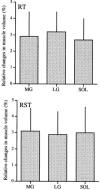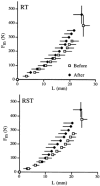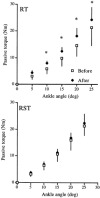Effects of resistance and stretching training programmes on the viscoelastic properties of human tendon structures in vivo
- PMID: 11773330
- PMCID: PMC2290007
- DOI: 10.1113/jphysiol.2001.012703
Effects of resistance and stretching training programmes on the viscoelastic properties of human tendon structures in vivo
Abstract
The present study examined whether resistance and stretching training programmes altered the viscoelastic properties of human tendon structures in vivo. Eight subjects completed 8 weeks (4 days per week) of resistance training which consisted of unilateral plantar flexion at 70 % of one repetition maximum with 10 repetitions per set (5 sets per day). They performed resistance training (RT) on one side and resistance training and static stretching training (RST; 10 min per day, 7 days per week) on the other side. Before and after training, the elongation of the tendon structures in the medial gastrocnemius muscle was directly measured using ultrasonography, while the subjects performed ramp isometric plantar flexion up to the voluntary maximum, followed by a ramp relaxation. The relationship between estimated muscle force (F(m)) and tendon elongation (L) was fitted to a linear regression, the slope of which was defined as stiffness. The hysteresis was calculated as the ratio of the area within the F(m)-L loop to the area beneath the load portion of the curve. The stiffness increased significantly by 18.8 +/- 10.4 % for RT and 15.3 +/- 9.3 % for RST. There was no significant difference in the relative increase of stiffness between RT and RST. The hysteresis, on the other hand, decreased 17 +/- 20 % for RST, but was unchanged for RT. These results suggested that the resistance training increased the stiffness of tendon structures as well as muscle strength and size, and the stretching training affected the viscosity of tendon structures but not the elasticity.
Figures





References
-
- Almeida-Silveira MI, Lambertz D, Perot C, Goubel F. Changes in stiffness induced by hindlimb suspension in rat Achilles tendon. European Journal of Applied Physiology. 2000;81:252–257. - PubMed
-
- Amiel D, Woo SLY, Harwood FL, Akeson WH. The effect of immobilization on collagen turnover in connective tissue: a biochemical-biomechanical correlation. Acta Orthopaedica Scandinavica. 1982;53:325–332. - PubMed
-
- Behm DG, Sale DG. Intended rather than actual movement velocity determines velocity-specific training response. Journal of Applied Physiology. 1993;74:359–368. - PubMed
-
- Butler DL, Grood ES, Noyes FK, Zernicke RF. Biomechanics of ligaments and tendons. Exercise and Sports Science Reviews. 1978;6:125–181. - PubMed
-
- Danielsen CC, Andereassen TT. Mechanical properties of rat tail tendon in relation to proximal-distal sampling position and age. Journal of Biomechanics. 1988;21:207–212. - PubMed
MeSH terms
LinkOut - more resources
Full Text Sources

